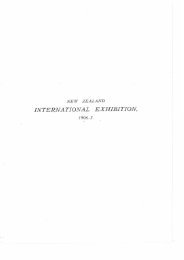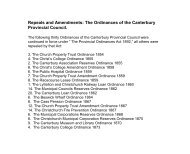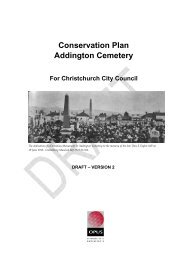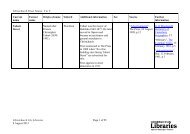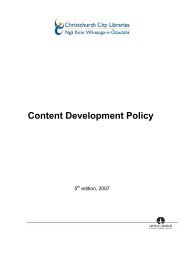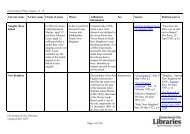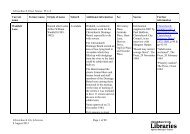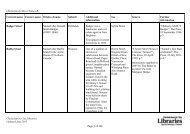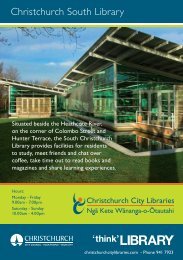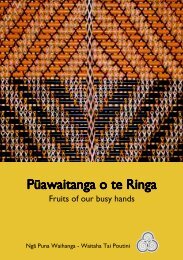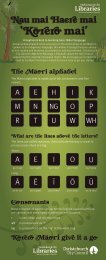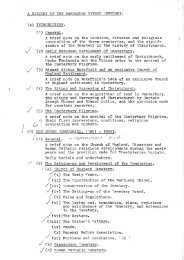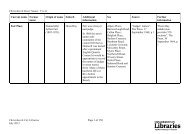Rich man, poor man, environmentalist, thief - Christchurch City ...
Rich man, poor man, environmentalist, thief - Christchurch City ...
Rich man, poor man, environmentalist, thief - Christchurch City ...
You also want an ePaper? Increase the reach of your titles
YUMPU automatically turns print PDFs into web optimized ePapers that Google loves.
When establishing its settlement, the Canterbury<br />
Association laboured mightily to include among<br />
its attractions a fee-paying high school for the<br />
sons of the well-to-do. Little consideration was given to the<br />
possibility that the daughters of the prosperous might seek a<br />
similar boon and thus there was no provision for a Christ’s<br />
College for girls. Nevertheless, the upwardly mobile did<br />
de<strong>man</strong>d a high school education for their daughters and it was<br />
Maria Thomson who filled this gap in the market.<br />
In December 1852, at Gravesend, Maria Thomson, 43,<br />
boarded the Lyttelton-bound vessel Hampshire. She did not<br />
quibble at the fact that, for six weeks, winds confined the ship<br />
off the coast of England:<br />
‘In the placid beauty of calm weather and the awful grandeur<br />
of the storm – in the boundless roll of the ocean and the<br />
glorious expanse of the heavens – I feel an intense worshipful<br />
admiration and a peaceful enjoyment far more perfect than<br />
usually falls to the lot of any on the busy land.’<br />
The Hampshire finally reached its destination on 6 May<br />
1853.<br />
To Maria it was of the utmost importance that she find, in<br />
Canterbury, ‘a happy and prosperous home’. Although from<br />
a cultured background and experienced at teaching the<br />
daughters of the well-heeled, she had suffered ‘great vicissitude<br />
... and unusually sharp trial’. Whether her husband, Charles<br />
Thomson, had contributed to these problems is uncertain. It<br />
is clear, however, that, in an age when a wo<strong>man</strong>’s persona was<br />
absorbed within that of her spouse, Maria was an extreme<br />
conformist. In her advertisements, even in her death notice,<br />
she is Mrs Charles Thomson; only in land records and her<br />
will is she Maria. Yet when she arrived in <strong>Christchurch</strong>, she<br />
was already a widow.<br />
Maria purchased, for £220, parts of Town Sections 1047<br />
and 1049, a 43 perch property situated towards the western<br />
end of Oxford Terrace. On this site, on 22 March 1854, she<br />
opened the ‘<strong>Christchurch</strong> Ladies’ School’ in a building called<br />
‘Avon House’. The school, which catered for day girls and<br />
boarders, subjected both groups to a well organised regime.<br />
Boarders had hair brushing for eight minutes, both night and<br />
morning, and twice each Sunday, trooped off to divine service<br />
at St Michael’s. An honour much sought after by younger<br />
pupils was that of carrying the lamp which lit the path at<br />
night. Maria’s curriculum included the genteel female<br />
accomplishments – pianoforte, guitar and singing – but other<br />
disciplines included writing, arithmetic, English, drawing and<br />
a strong dose of foreign languages – Latin, French, Ger<strong>man</strong><br />
and Italian. The pupils’ limited spare time was spent in picnics<br />
and simple games, of which hopscotch was a favourite.<br />
The surnames of Maria’s pupils are a roll-call of families<br />
who were climbing or already at the top of the greasy social<br />
pole – Boag, Alport, Brittan, Ollivier, Mathias, Moorhouse,<br />
Deamer, Caverhill, Miles, Coward, Barker and Gresson.<br />
Doubtless each girl learned the skills needed to <strong>man</strong>age a large<br />
household and a socially prominent spouse. But there were<br />
problems. Infections spread quickly in crowded classrooms<br />
and bedrooms, and, sometimes, there e<strong>man</strong>ated from the<br />
school an overpowering smell of disinfectant.<br />
One pupil, Mary Brittan, sought to stage a farce, the Old<br />
maid. Alas, of the eight characters, five were male. Maria<br />
vetoed a scheme to have, in the male roles, either young men<br />
or girls dressed in trousers. Instead a reluctant Mary organised<br />
a game of charades. Mary Brittan was, however, a pupil on<br />
whom Maria would smile. She married William Rolleston in<br />
1865 and, three years later, he became Superintendent. As first<br />
lady of Canterbury, Mary was an unofficial but charming and<br />
Maria Thomson<br />
(1809 – 1875)<br />
Maria Thomson<br />
Weekly press: jubilee number, 15 December 1900,<br />
p98<br />
7



